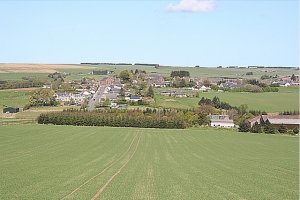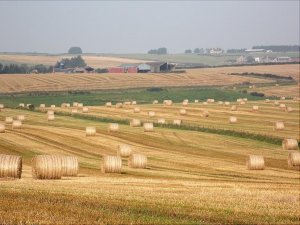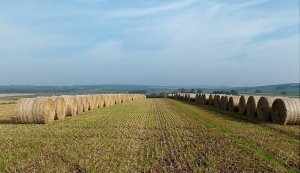New Byth

In a desperate search for inspiration, I'm looking out of my lounge window. John (usually known as Jocky)
is standing in the middle of the road talking in his Doric brogue to a neighbour. They are in no danger
for little traffic comes along this narrow road, and if it did, the driver might well stop and join in the conversation.
Jocky is the village's oldest resident and has lived for 91 of his 93 years in the same brightly painted cottage.
In his garden are three flagpoles and Jocky has a seeming endless collection of flags which he regularly and randomly flies.
Tucked away in N.E. Scotland, this is not the land of high mountains and deep glens, but rather of soft rolling
hills and fields of barley and wheat. This particular area is called (on old maps) 'Fishtown'. Nothing to do with fish
but from the Gaelic for "Town by a mossy burn", and I think this is where the locals would have dug peat for fuel.
New Byth is a typical planned village founded in 1765 by James Urquhart esq.
Apparently he had intended to join the earlier Jacobite uprising, but was persuaded that this was unwise and to seek his
fortune elsewhere.
The original village consisted of a few cottages around the Byth House (from the Gaelic Byth = Birch tree)
but the new village, built to encourage the linen and wool industry, was laid out with each
thatched house having a weaving shed. Most of the villagers would have rented small lots of ground
in addition to their plots of about 1/5 acre. The houses were built using locally quarried sandstone and over time,
the original thatch was replaced by slate quarried in the west of Scotland.
Urquhart's plan was to produce a coarse linen cloth called Osnaburg for the slave trade in the West Indies.
To this end, he built a 'Manufactory' with 13 looms, but the project was unsuccessful and the weaving shed became
a 'Chapel of Ease'. (This is a place of worship for people who could not travel to the parish church 9 miles away
in King Edward.) The building no longer exists, but the street name'Chapel Lane' still does.
The population of 195 rose to 609 by 1871 then went into rapid decline as imported cotton made the looms redundant.
By 1899 there were only two looms left. Whilst the village attracted shops, tradesmen and tailors it gained a respectable
reputation for the quality and quantity of shoemakers (called a Souter in Scotland).
The school was built in1860 to replace a dame school (an early form of private school with women teachers) and a chapel school
and was designed to hold 180 pupils. A new primary school was built in 1939 but it closed at the beginning of
this century when the school role fell to 6.

At its peak, the village boasted a wide range of trades.
The best guide to these occupations is in the Post Office directories, but their use is limited because individual
addresses are not identified. Nevertheless, I can see that in the village were general merchants, wine & spirit merchants,
blacksmiths, teachers and of course, the church minister. Of the more exotic professions,
there was a book binder and a surgeon.
There were also the 'characters'! Foremost anongst these was Francis Jamieson, born the 18th July, 1823.
A superb musician and athlete, he was born and lived all his life in a cottage with dry stone walls and a thatched roof
of heather and grass, just outside New Byth.
Francis could match any athlete on the field in shot-putt, hammer throwing or weight-slinging,
but his prowess was in running. On one occasion he was said to have won a race at the Badenscoth games, and ran through the
night to compete in the Elgin games, some sixty miles away.
Francis's nephew, Joseph Sim, the "Wonderful Boy" of New Byth, was also a skilful fiddler, who had his own dance band and with
whom Francis often played at local dances. Joseph was also a fine athlete and so features in some of the, perhaps, apocryphal stories
of himself and Francis.
Not long after the opening of the Buchan railway line Francis was challenged to race the steam train from Aikey Brae,
near Mintlaw, famous for the traveller’s horse fair, to Maud, the next village on the line.
The engine narrowly won and when it steamed into the station, followed by Francis, he shook his fist and shouted,
"Ye muckle black bugger! Gin I hid ye on the Moss o’ Byth I’d hae gaen ye a reed face!" (muckle = big)
Francis Jamieson’s skills on the field were matched with his dexterity as a musician. He was described as – "A master with the cello, an angel with the fiddle,
and a devil with the oxter pipes."
There is a story that he won his 'oxter pipes' in a competition and thereafter learned to play along with his bass fiddle and cello.
In “Oxter Pipes” – (Oxter = armpits) the bellows are pumped by the arm – a bit like the Northumbrian Pipes or the Irish Uilleann Pipes.
His appetite, amongst other things, was legendary and he was known to have eaten a whole turkey in one sitting.
He died on the 19th September 1903 in poverty, still in his "thackit stane hoosie"
and was buried in the cemetery at New Byth.
Today, the village has lost all its amenities and you have to visit one of the nearby towns for just about anything.
At least, the roads have improved and it is possible to travel easily and quickly. If you looked at an old map of New Byth
you could recognise most of the features on it. It has barely changed in size and government seems reluctant to invest in these
small communities. This is both a blessing and a curse. I would hate to see the place expand too much.
I love the open spaces all round me but I can't just drop into the village shop or have a beer at my local pub.
But I love living here.




